Effective Public Relations: A Guide - Rotary International
Effective Public Relations: A Guide - Rotary International
Effective Public Relations: A Guide - Rotary International
Create successful ePaper yourself
Turn your PDF publications into a flip-book with our unique Google optimized e-Paper software.
effective<br />
public<br />
relations<br />
a guide for <strong>Rotary</strong> clubs
The practice of public relations varies<br />
throughout the world. Regardless of<br />
cultural differences from one country to<br />
another, all <strong>Rotary</strong> clubs have audiences<br />
with whom they should communicate,<br />
including the media, local government<br />
officials, the business community, civic<br />
leaders, and other organizations, as well as<br />
qualified prospective members and people<br />
directly affected by <strong>Rotary</strong> service projects.<br />
Developing a message for these audiences<br />
and finding an appropriate way to deliver it<br />
is public relations in action.<br />
Components of<br />
<strong>Public</strong> <strong>Relations</strong><br />
To understand what public relations entails, it helps to break<br />
it down into its separate components:<br />
• Understanding news<br />
• PR writing<br />
• Media relations<br />
• External relations<br />
• Nontraditional media<br />
This guide will help you develop and use traditional and<br />
nontraditional PR materials and methods, work with the<br />
media, develop cooperative relationships with non-<strong>Rotary</strong><br />
organizations, and evaluate and measure the success of<br />
your club’s PR efforts.<br />
1
What Is News?<br />
News has been described as extraordinary<br />
things happening to ordinary people and<br />
ordinary things happening to extraordinary<br />
people. The following elements are considered<br />
by many to make up “news”:<br />
• Immediacy. Timing, or immediacy, is<br />
important to getting your story in the<br />
media. Using words like today, yesterday,<br />
early this morning, and tomorrow are all<br />
examples of using immediacy. Reporting<br />
something that has just happened<br />
or is about to happen is critical for a<br />
story to become news.<br />
• Proximity. If the story you are pitching<br />
happened outside your community,<br />
city, state, or country, would you be<br />
interested in reading about it? By asking<br />
this simple question, you can tell if<br />
your story is newsworthy. Newspapers<br />
and other media sources largely focus<br />
on hometown and regional stories. The<br />
more localized a story is, the greater<br />
the chance it will be used.<br />
• Prominence. Does your story feature<br />
public figures or officials, people of<br />
renown, or those who pique curiosity?<br />
In general, such people of influence can<br />
make the news. To qualify, your club’s<br />
visitor or speaker must be able to gain<br />
the readers’ attention either by reputation<br />
or by the topic being discussed.<br />
• Singularity. In many places in the<br />
world, the unusual and the unexpected<br />
often make news. For example, if your<br />
club has accomplished a challenging or<br />
unusual project in your community or<br />
another part of the world, or if one<br />
of your members has performed an<br />
incredible service, be sure to use this<br />
angle to create a news piece.<br />
• Conflict. Unfortunately, conflict is one<br />
element that makes headlines worldwide.<br />
Be proactive and share what<br />
your club is doing to build goodwill and<br />
2<br />
peace in the world. An op-ed piece in<br />
response to a recent story on conflict<br />
would be a good start.<br />
• Emotional appeal. Often called<br />
human interest stories, news pieces<br />
that elicit the reader’s sympathy or<br />
other emotional responses make great<br />
feature-type stories. Does your club<br />
have a compelling story that will capture<br />
the interest of the general public<br />
as well as <strong>Rotary</strong> club members?<br />
• Consequence. For a story to show<br />
consequence, it must be important<br />
to a vast number of readers. Does<br />
your club’s story affect other people’s<br />
lives? Try to focus on the efforts and<br />
reactions of one or two people to<br />
humanize the story as much as possible.<br />
Share your club’s efforts on polio<br />
eradication, clean water, environmental<br />
stewardship, or other critical issues<br />
to demonstrate that if <strong>Rotary</strong> weren’t<br />
active in this area, there would be<br />
negative consequences.<br />
Experience shows clubs have been<br />
most successful in promoting the<br />
following types of <strong>Rotary</strong> stories:<br />
• Outstanding volunteers<br />
• Interactions between people in<br />
developed and developing countries<br />
• Local <strong>Rotary</strong> or <strong>Rotary</strong> Foundation<br />
projects<br />
• <strong>Rotary</strong> <strong>International</strong> studies and<br />
exchange program participants<br />
(Youth Exchange students, <strong>Rotary</strong><br />
World Peace Fellows, Ambassadorial<br />
Scholars, or Group Study Exchange<br />
team members)<br />
• Human interest stories about people<br />
who benefited from <strong>Rotary</strong> service<br />
• PolioPlus activities, particularly in<br />
polio-endemic areas
PR Writing<br />
The ability to write easily, logically, and succinctly<br />
is vital in public relations. The object<br />
of most PR writing is to grab the reader’s<br />
attention. Most press releases and other<br />
written communications for the media use<br />
an inverted-pyramid style, with the most<br />
important and relevant information at the<br />
top, followed by gradually less important<br />
information.<br />
Lead<br />
Most Important Information<br />
Additional Facts<br />
Background<br />
Writing a Press Release<br />
The headline and the first sentence are the<br />
two most important parts of a press release.<br />
Make sure they are compelling enough to<br />
draw the editor or reporter in. Use active<br />
verbs in headlines, making them brief and<br />
to the point.<br />
• Develop a well-thought-out “news<br />
hook,” a persuasive reason for the<br />
news media to pursue a story. The<br />
news hook provides direction to<br />
the rest of the release.<br />
• Always define <strong>Rotary</strong> as “a global<br />
network of community volunteers”<br />
in the release.<br />
• Determine who will be the contact<br />
person for media inquiries, and place<br />
that person’s name, e-mail address,<br />
and phone number in the upper-left<br />
corner. A reporter or editor will more<br />
likely follow up when your contact<br />
information is easily available. If your<br />
club or district Web site is current, also<br />
include the Web address.<br />
Lead paragraph<br />
Include the five Ws in your first paragraph,<br />
ideally in the first sentence:<br />
• Who? The main focus of your story —<br />
a person or group of people that is the<br />
essential element of the story<br />
• What? The event or project with<br />
which your club is involved<br />
• Where? The location of the event,<br />
including a street address<br />
• When? The time, day, and date of an<br />
event or the time period involved for<br />
a person or project<br />
3<br />
• Why? The reason this event, person,<br />
or project is significant to the general<br />
public<br />
Additional paragraphs<br />
In subsequent paragraphs, describe details<br />
about the event or project or how the<br />
person achieved something extraordinary.<br />
Keep your release concise. State opinions<br />
in quotes from club leaders, project beneficiaries,<br />
or person being featured or honored.<br />
Decide what information is necessary<br />
and then focus on one or two main points.<br />
Limit the release to one page.<br />
If you’re sending a release to a television<br />
station, think of its visual needs. Suggest<br />
good video footage opportunities, such<br />
as unusual events, colorful scenes, smiling<br />
children, or celebrity appearances.<br />
Pitching Yourself as “The Expert”<br />
Journalists are always looking for experts on<br />
a variety of topics for feature stories. Send a<br />
letter to a specific reporter with an idea for<br />
a story and offer your help in developing it.<br />
Describe why you or someone in your club<br />
qualifies as an expert on a particular issue,<br />
such as literacy, water, eliminating global<br />
poverty, environmental stewardship, or
conflict resolution. Include the names of<br />
people available for interviews, project<br />
information, and related story angles. Tailor<br />
the letter to the reporter and the medium<br />
as much as possible. Consider these tips:<br />
• Summarize your pitch in one page.<br />
• Explain why readers would be<br />
interested.<br />
• Detail the scope and significance of<br />
your project.<br />
• Provide a few interesting details.<br />
•<br />
•<br />
Offer alternate approaches to the<br />
story when possible.<br />
Describe possible photo opportunities.<br />
A picture is worth 1,000 words<br />
Photos increase interest in your story<br />
and give your release an extra edge.<br />
They should be an essential part of<br />
every PR plan. Consider these tips to<br />
help ensure a great photo:<br />
• Plan ahead. Determine the message<br />
you want to convey, and find a way to<br />
capture it in a photo.<br />
• Use a professional photographer or<br />
high-quality digital camera.<br />
• Take action shots. Images featuring<br />
hands-on activity create more interest<br />
than posed shots of people shaking<br />
hands and standing and facing the<br />
camera. A creative, active shot could<br />
be the deciding factor for an editor on<br />
whether to run a story.<br />
• Keep deadlines in mind. Send timely<br />
photos to the media well in advance<br />
of publishing deadlines. Make sure<br />
to include a caption with the correct<br />
spelling of names and a sentence<br />
explaining the event. Use the who,<br />
what, where, when, and why format to<br />
write captions.<br />
• Download current photos of RI officers<br />
at www.rotary.org.<br />
4<br />
Letter to the Editor<br />
The editorial page is one of the most-read<br />
sections of the newspaper, and your letter<br />
can reach many people. Keep these tips in<br />
mind when sending a letter to the editor:<br />
• Make one or two points and state<br />
them clearly, ideally in the first<br />
sentence.<br />
• Make your letter timely. If you aren’t<br />
addressing a specific article, editorial,<br />
or letter that ran recently, tie your<br />
comment to a recent event.<br />
• Familiarize yourself with the coverage<br />
and editorial position of the paper.<br />
Refute or support specific statements<br />
and address relevant facts that had<br />
been ignored, but avoid attacking the<br />
media in general or the newspaper in<br />
particular.<br />
• Check the letter specifications of the<br />
newspaper. Length and format requirements<br />
vary from paper to paper (about<br />
two short paragraphs are ideal). Remember<br />
to include your full name, title<br />
(if applicable), mailing address, e-mail<br />
address, and daytime phone number.<br />
Op-Ed<br />
An op-ed (positioned opposite the editorial<br />
page) is an opinion piece written by an<br />
individual who is not on the newspaper’s<br />
staff. Before writing an op-ed for your paper,<br />
learn what topics are of interest to your<br />
community. An op-ed should:<br />
• State a point of view<br />
• Provoke thought<br />
• Stimulate discussion<br />
Review the op-ed pieces in your paper<br />
before submitting your own. Like a letter<br />
to the editor, an op-ed should be brief and<br />
clearly stated.
Fact Sheet<br />
A fact sheet provides details about<br />
<strong>Rotary</strong> programs to ensure journalists<br />
have accurate background information. You<br />
can download <strong>Rotary</strong> fact sheets from the<br />
<strong>Public</strong> <strong>Relations</strong> section at www.rotary.org.<br />
Media Kit<br />
On occasion, reporters require more<br />
information than appears in a press release,<br />
particularly at events.<br />
A media kit is a pocket folder, preferably<br />
with a <strong>Rotary</strong> identifier, that holds general<br />
information about <strong>Rotary</strong> and your club as<br />
well as materials tailored to the event.<br />
Your media kit should include:<br />
• A fact sheet or brochure about<br />
your club<br />
• A fact sheet or news release about<br />
the project or event<br />
• A fact sheet about the <strong>Rotary</strong><br />
program involved<br />
PR Writing Case Study<br />
<strong>Rotary</strong> Responds to News of<br />
U.S. Polio Cases<br />
In 2005, U.S. health officials were<br />
surprised to discover that five children<br />
in an Amish community in Minnesota<br />
were infected by the poliovirus.<br />
Polio hadn’t been seen in the United<br />
States for 26 years. In response to a<br />
Washington Post article covering the<br />
outbreak, RI posted a sample letter<br />
to the editor in its <strong>Rotary</strong> PR Tips<br />
newsletter, emphasizing that no child<br />
is safe from polio until the disease<br />
is eradicated worldwide. It stated:<br />
5<br />
<strong>Rotary</strong> members worldwide are committed<br />
to immunizing every child and<br />
have made eradicating polio their top<br />
priority since 1985. <strong>Rotary</strong> and its partners<br />
at the World Health Organization,<br />
U.S. Centers for Disease Control and<br />
Prevention, and UNICEF have immunized<br />
more than two billion children in<br />
122 countries.<br />
RI’s <strong>Public</strong> <strong>Relations</strong> Division also<br />
developed an opinion piece and sent it<br />
to district governors and club presidents,<br />
encouraging them to submit it<br />
to their local newspaper. Through<br />
these actions, many letters and opinion<br />
pieces were published, and Rotarian<br />
voices were heard all over the world.<br />
Media <strong>Relations</strong><br />
Just as manufacturers market their products,<br />
<strong>Rotary</strong> members must “sell” stories to the<br />
media. Understanding the media will help<br />
you market <strong>Rotary</strong>’s message successfully.<br />
Identifying Media Targets<br />
Before sending stories to a journalist, get<br />
to know your audience. Read your local<br />
newspaper and watch television programs<br />
to identify particular columns or segments<br />
where a <strong>Rotary</strong> story could be placed.<br />
Consider inviting a local journalist to speak<br />
to your club about how to work with the<br />
media. This will give you an opportunity<br />
to get to know the journalist and better<br />
understand the news process.<br />
Identify your target media. These might<br />
include regional or suburban newspapers,<br />
local radio stations, media that cover one<br />
specific topic — for instance, education<br />
or health — and local television and cable<br />
stations.
Developing a Media List<br />
After identifying media targets, put together<br />
a contact list for each story that includes<br />
the names, phone numbers, fax numbers,<br />
and e-mail addresses of journalists, editors,<br />
or news directors who might take a special<br />
interest in <strong>Rotary</strong>. Larger newspapers or<br />
broadcast stations may have departments<br />
or reporters specializing in certain topics<br />
such as business, features, medical news,<br />
event calendars, or education. A business<br />
writer may be interested in a club’s career<br />
day for students, while an education writer<br />
may wish to interview an exchange student<br />
or an Ambassadorial Scholar.<br />
Contacting the Media<br />
You can take your story to the media several<br />
ways. Whatever approach you choose,<br />
be persuasive, persistent, and friendly — but<br />
not aggressive. The most effective methods<br />
depend on the journalist’s preferences. Here<br />
are some suggested approaches:<br />
• E-mail. Most reporters use e-mail and<br />
appreciate the time it saves identifying<br />
worthwhile stories. Like a headline,<br />
your subject line should be well<br />
thought out; it can make the difference<br />
between your e-mail being read or<br />
deleted.<br />
• Phone. Many editors prefer a brief<br />
(less than two minutes) phone description<br />
of a story, along with the reasons<br />
it would interest readers or viewers.<br />
They will then tell you if they are<br />
interested and if they need additional<br />
materials.<br />
• Fax. Faxes are an inexpensive and fast<br />
way to send information requested by<br />
a reporter or editor or to deliver timesensitive<br />
materials. Most reporters<br />
discourage unsolicited faxes. A news<br />
advisory concisely ticks off the who,<br />
what, when, where, and why — often<br />
with times and places underscored to<br />
catch a busy editor’s eye.<br />
6<br />
• Mail. Use the mail for sending onepage<br />
letters outlining your ideas or<br />
background materials for stories without<br />
an immediate deadline.<br />
• Personalized letter. Sent alone or<br />
with a press release, a letter can point<br />
out a specific angle or suggest story<br />
ideas or good interview subjects and<br />
show you’ve taken the time to consider<br />
what might interest that particular<br />
reporter.<br />
• Press kit. A press kit can be effective if<br />
you have several related stories to tell<br />
or a number of related events to promote,<br />
such as a month-long series of<br />
speakers. In addition to a fact sheet and<br />
release, it may contain photos (with<br />
captions attached), a calendar of events,<br />
and brief biographies of the <strong>Rotary</strong><br />
club members involved.<br />
Some news should be targeted to specific<br />
media, including:<br />
• Calendar items. Magazines, newspapers,<br />
and radio and TV stations have<br />
calendar editors, who list upcoming<br />
events. To inform the media about your<br />
club meeting or event, send the calendar<br />
editor one paragraph detailing the<br />
program, place, and time.<br />
• PSAs. <strong>Public</strong> service announcements<br />
are nonpaid “commercials” that RI has<br />
developed for clubs to send to their<br />
local media outlets, including TV and<br />
radio stations. Both DVD and Beta SP<br />
tapes are available. Contact the station’s<br />
public service director to see if the<br />
station would be interested in receiving<br />
<strong>Rotary</strong> PSAs. Send all requests to<br />
pr@rotary.org.<br />
Conducting Interviews<br />
with the Media<br />
Journalists are always looking for good<br />
human-interest stories. Equally valuable<br />
is a knowledgeable messenger. Develop
informed, articulate spokespersons who<br />
are easily accessible and well-versed about<br />
<strong>Rotary</strong>’s programs. Good candidates include<br />
international, district, and club officers and<br />
people who have benefited from <strong>Rotary</strong><br />
programs, such as Ambassadorial Scholars,<br />
Group Study Exchange team members,<br />
Youth Exchange students, <strong>Rotary</strong> World<br />
Peace Fellows, and <strong>Rotary</strong> Volunteers. When<br />
a non-Rotarian expert or celebrity is participating<br />
in a <strong>Rotary</strong> event, make sure they<br />
are adequately informed to convey the right<br />
message about <strong>Rotary</strong>.<br />
Consider the following points, to ensure<br />
that when a journalist calls for an interview,<br />
you present your story in the best light:<br />
• Provide the reporter with background<br />
materials, including a short biography<br />
of the person to be interviewed,<br />
beforehand.<br />
• Know your main points and rehearse<br />
them before the interview.<br />
• Remember your audience. Make comments<br />
that will interest the people<br />
who read the article or see or hear<br />
the broadcast.<br />
• Be articulate and concise. Present the<br />
facts in a simple, direct manner.<br />
• Avoid <strong>Rotary</strong> jargon (for example, PDG,<br />
GSE, makeups).<br />
• Ask the reporter to clarify his or her<br />
question, if necessary.<br />
• Understand that everything said to<br />
a reporter is on the record, regardless<br />
of a reporter’s assurances to the<br />
contrary.<br />
• If a reporter asks a negative question,<br />
answer honestly and try to steer the<br />
conversation to positive ground.<br />
• It’s OK to ask when the story will run,<br />
but avoid asking the reporter to show<br />
you the story before it appears.<br />
• Make sure the reporter has a phone<br />
number where he or she can contact<br />
you for additional information.<br />
7<br />
Quick tips<br />
• Familiarize yourself with the publication<br />
or TV news program that you<br />
would like to publish or air your story.<br />
• Keep media lists current. Personalize<br />
your materials as much as possible.<br />
• Contact the media only with newsworthy<br />
story ideas.<br />
• Call reporters during times other than<br />
deadline. Mornings are usually best.<br />
• Know your story and anticipate<br />
questions.<br />
• Send background materials immediately<br />
following contact.<br />
• Be available. Make sure you are<br />
available to take journalists’ calls if<br />
they need more information or want<br />
to check a fact for accuracy.<br />
• Always work within a reporter’s<br />
deadlines.<br />
• Let your club members know when<br />
you send out information to the press.<br />
• Take no for an answer. You have a<br />
great story and compelling photos —<br />
but still no interest. What can you do?<br />
Accept the reporter’s decision. Arguing<br />
with reporters only alienates them<br />
and will hurt your chances of placing<br />
future stories.<br />
Managing Crisis<br />
Despite your best efforts, problems may<br />
develop that are sensitive in nature. Be<br />
forthcoming if a reporter calls, but avoid<br />
initiating contact with the media about<br />
unflattering stories.<br />
When a situation arises that you think will<br />
need immediate attention, contact <strong>Rotary</strong><br />
<strong>International</strong> before you speak with the<br />
media (phone: +1-847-866-3237; e-mail:<br />
pr@rotary.org).
Keep in mind these general rules for crisis<br />
communications:<br />
• Provide a straightforward response.<br />
• Don’t speculate.<br />
• Shift to a more neutral or, if possible,<br />
positive message.<br />
When information gets out quickly, rumors<br />
are stopped and nerves are calmed. The goal<br />
is to terminate the crisis, limit the damage,<br />
and restore credibility.<br />
Consider the following factors to help lessen<br />
or alleviate potential negative publicity:<br />
• Surprise. A public relations crisis is<br />
usually unexpected. You may learn of<br />
the situation only when a reporter calls<br />
for comment. Don’t feel pressured to<br />
give a quote immediately. Instead, find<br />
out what the reporter wants, assure<br />
him or her that you will respond, and<br />
then get off the phone. Seek advice<br />
before making a statement or answering<br />
a critical question. Contact <strong>Rotary</strong><br />
<strong>International</strong> if needed, but don’t hide<br />
from the media.<br />
• Insufficient information. Rumors may<br />
fly. Avoid reacting or commenting on<br />
something that hasn’t been substantiated.<br />
Also avoid saying “no comment,”<br />
which could be used to insinuate guilt.<br />
Instead, say that you will check out the<br />
matter more fully and get back to the<br />
journalist.<br />
• Escalating events. The crisis broadens.<br />
Additional media pick up the story or<br />
the situation becomes more complicated.<br />
Remain calm and keep the<br />
long-term picture in mind. As much as<br />
possible, tell the full story and tell it<br />
promptly.<br />
Too long of a delay could put your club<br />
in a negative light.<br />
• Increased scrutiny. The public feed on<br />
rumors. “Helpful” politicians, local leaders,<br />
and others may make observations<br />
that complicate the situation. Channel<br />
8<br />
all <strong>Rotary</strong> comments through one<br />
spokesperson and ask club members<br />
to refrain from speaking about the<br />
incident and to refer journalists to the<br />
designated club spokesperson.<br />
• Siege mentality. When an organization<br />
feels attacked, it tends to immediately<br />
shut down to defend itself. Resist<br />
the natural impulse to protect yourself.<br />
Seek legal and public relations counsel<br />
when necessary, but remain as open to<br />
the media and the public as possible.<br />
<strong>Rotary</strong> is not a secret organization and<br />
should not be portrayed as such.<br />
• Panic. Nerves start to wear thin when<br />
the possibility of negative publicity arises.<br />
Remain calm, seek counsel, tell the<br />
truth, and position the club as an open<br />
organization. This will help to stem<br />
further eruptions and most effectively<br />
communicate <strong>Rotary</strong>’s message.<br />
When a difficult situation has been resolved,<br />
contact the press and let them<br />
know immediately.<br />
Media <strong>Relations</strong> Case Study<br />
Local Story Makes National News<br />
An article in the San Diego Tribune<br />
about Fary Moini, a member of the<br />
<strong>Rotary</strong> Club of La Jolla Golden Triangle,<br />
California, USA, caught the eye of a<br />
producer from NBC Nightly News. After<br />
reading it, he contacted the club to<br />
discuss doing a story about her. Honoring<br />
Moini as a “hometown hero,” the<br />
article praised her extraordinary work<br />
to aid Afghan refugees in Pakistan and<br />
Afghanistan and highlighted her <strong>Rotary</strong><br />
experience and its impact on others<br />
in the world. In the story, she said, “I<br />
belong to a great organization, <strong>Rotary</strong><br />
<strong>International</strong>, and with their encouragement,<br />
with their support, I was able<br />
to do these small things with love.”
After gathering background information,<br />
the NBC Nightly News produced a human<br />
interest piece featuring Moini’s efforts as<br />
part of the show’s “Making a Difference”<br />
series. The 2:40-minute broadcast was<br />
seen by millions of viewers. It focused<br />
on how Moini worked with her <strong>Rotary</strong><br />
club to raise US$250,000 to construct<br />
a school equipped with a science lab,<br />
library, and computer room for 2,000<br />
children in war-ravaged Jalalabad,<br />
Afghanistan. The NBC team followed<br />
her to Afghanistan and shot footage of<br />
the opening of the mixed-gender school.<br />
Moini was interviewed during the piece<br />
and was able to share <strong>Rotary</strong> with the<br />
world, all of which provided great coverage<br />
for <strong>Rotary</strong> and allowed viewers to<br />
see how Rotarians are active in both<br />
their communities and around the world.<br />
And, it all began with local news coverage.<br />
External <strong>Relations</strong><br />
Working with other organizations, known as<br />
external relations, is an important component<br />
of public relations today. <strong>Rotary</strong> clubs and<br />
districts are encouraged to collaborate on<br />
projects with other groups locally, nationally,<br />
and internationally.<br />
<strong>Rotary</strong> <strong>International</strong> has a long history of<br />
working with other organizations. The first<br />
<strong>Rotary</strong> service project — the building of<br />
public washrooms near Chicago’s city hall —<br />
was completed through the cooperation of<br />
civic agencies and key local business leaders.<br />
Today, <strong>Rotary</strong> is a spearheading partner in the<br />
Global Polio Eradication Initiative, an alliance<br />
that serves as a model for private-public sector<br />
collaboration. Working with other organizations<br />
can help increase public awareness of<br />
your club’s activities, multiply the impact of a<br />
project, and expand your access to technical<br />
and financial resources.<br />
9<br />
Recognizing the importance of developing<br />
and maintaining partnerships, <strong>Rotary</strong> <strong>International</strong><br />
established the <strong>Rotary</strong> representative<br />
network. More than 20 representatives to<br />
the United Nations, its agencies, and other<br />
major international organizations participate<br />
in international meetings and events on behalf<br />
of <strong>Rotary</strong>. These representatives, appointed<br />
each year by the RI president, are listed in<br />
the Official Directory. Draw on their expertise<br />
if your club is considering working with<br />
another organization with which RI has<br />
official relations.<br />
Tips for Collaborative <strong>Relations</strong>hips<br />
• Develop clear guidelines of what is<br />
expected from each party.<br />
• Ask the cooperating organization to<br />
feature information on your joint project<br />
on its Web site. Make sure the site also<br />
includes information about your club or<br />
district and a link to your Web site.<br />
• Host local events such as sports competition,<br />
parades, or musical activities<br />
to raise funds for your mutual cause and<br />
highlight the cooperation between your<br />
club and the other organization.<br />
• Issue joint press releases to keep the<br />
media informed of your activities.<br />
Find out more about working with other<br />
organizations at www.rotary.org.<br />
External <strong>Relations</strong> Case Study<br />
<strong>Rotary</strong> Clubs Partner with<br />
Center for Global Safe Water<br />
More than one billion people throughout<br />
the developing world live without safe<br />
water, and over two billion lack adequate<br />
sanitation. Every year, more than 2.2 million<br />
deaths occur because of contaminated<br />
water, mostly children under age<br />
five. In response to the ongoing need to<br />
provide safe water in developing countries,<br />
the UN Millennium Development<br />
Goal for water and sanitation was devel-
oped, created to reduce the proportion<br />
by half of the world’s population<br />
without access to safe water by 2015.<br />
The <strong>Rotary</strong> Safe Water Project, a<br />
two-year initiative in Kenya, started in<br />
April 2005. The <strong>Rotary</strong> Club of Atlanta,<br />
Georgia, USA, and <strong>Rotary</strong> clubs in Kenya<br />
partnered with Emory University’s<br />
Center for Global Safe Water (CGSW),<br />
and the U.S. Centers for Disease<br />
Control and Prevention (CDC) creating<br />
the Safe Water and AIDS Project<br />
in western Kenya’s Nyanza Province.<br />
This Kenyan-based nongovernmental<br />
organization mobilizes rural community-based<br />
HIV/AIDS groups to<br />
become vendors of the Safe Water<br />
System, enabling them to earn an<br />
income, provide access to safe water,<br />
and support AIDS orphans and widows.<br />
Additionally, the <strong>Rotary</strong> club project<br />
has drilled more than 100 boreholes<br />
in two dry districts of eastern Kenya<br />
and acts as the local agent in managing<br />
the implementation of the well-drilling<br />
operation. A CGSW staff member<br />
in Kenya oversees the project and<br />
submits reports on its progress. CDC<br />
provides logistical help for the project,<br />
and the Center for Global Safe<br />
Water and the CDC perform joint<br />
research on the project’s health impact.<br />
10<br />
Through this nonprofit project, the<br />
cooperating organizations have made<br />
household water treatment and<br />
storage units available via commercial<br />
distributors and local artisans. In<br />
addition, local HIV/AIDS help groups<br />
have educated community members<br />
about health and home-based approaches<br />
to making water safe.<br />
Beyond<br />
Traditional<br />
Media<br />
<strong>Rotary</strong> clubs can improve their public image<br />
in ways other than news coverage. <strong>Rotary</strong><br />
<strong>International</strong> provides pre-produced PSAs<br />
for billboard and Internet advertisements<br />
and encourages all clubs to localize these<br />
materials for use in their communities.<br />
Cable and <strong>Public</strong>-<br />
Access Television<br />
In many areas of the <strong>Rotary</strong> world, public<br />
access or cable television provides commu-<br />
nity-based programming. Consult a cable<br />
company in your area to learn how your<br />
club might broadcast its service activities or<br />
weekly meetings or highlight<br />
special events and speakers.<br />
Some <strong>Rotary</strong> clubs have even<br />
taken advantage of cable television<br />
by producing and airing<br />
entire programs devoted to<br />
<strong>Rotary</strong>.<br />
<strong>Public</strong> Service<br />
Announcements<br />
Television and radio stations<br />
sometimes broadcast short<br />
announcements and messages
at no charge to community organizations<br />
such as <strong>Rotary</strong>. In addition, print media often<br />
have unsold advertising slots they offer as<br />
“remnant space” for free or at reduced rates<br />
to nonprofits. Notices of fundraisers, projects<br />
that benefit the community, scholarship availability,<br />
or public events sponsored by <strong>Rotary</strong><br />
are suitable subjects for PSAs.<br />
Print PSAs are available for download at<br />
www.rotary.org and can be used for news-<br />
paper or magazine placements. They can also<br />
be used for posters, air or rail terminal displays,<br />
community directories, program booklets,<br />
and banners. In addition, <strong>Rotary</strong> has PSAs<br />
and commercials that Rotarians can offer to<br />
their local radio and television stations.<br />
Building an <strong>Effective</strong> Web Site<br />
Clubs and districts are encouraged to create<br />
Web sites as an important way to communicate<br />
the <strong>Rotary</strong> message to the world. An<br />
effective Web site is designed with specific<br />
audiences in mind by developing different<br />
sections which focus on different users.<br />
Remember to keep your content clear<br />
and concise while avoiding <strong>Rotary</strong> jargon<br />
(e.g., DGE, PP, etc.). Updating your content<br />
regularly is important as well as making it<br />
interactive. Uploading images, audio, and<br />
video adds to the overall feel of the site.<br />
<strong>Rotary</strong> <strong>International</strong> encourages club and<br />
district Web sites to link to resources and<br />
articles at www.rotary.org. RI’s official Web<br />
site also features an RSS news feed that clubs<br />
and districts can incorporate into their sites’<br />
content for frequently updated <strong>Rotary</strong> news<br />
headlines.<br />
Billboards, Posters, and Signage<br />
Build <strong>Rotary</strong> awareness by creating billboards,<br />
posters, or signage to show what <strong>Rotary</strong><br />
is and what <strong>Rotary</strong> does. Use resources<br />
available through the RI Web site to create<br />
<strong>Rotary</strong> signage. The graphics may also be useful<br />
for publications, stationery, or other print<br />
materials.<br />
11<br />
Newspaper Supplements<br />
Spotlight the good work of <strong>Rotary</strong> at home<br />
and abroad by arranging for a local newspaper<br />
supplement. Ask club members to<br />
support the supplement by purchasing<br />
advertising space for their businesses. Then,<br />
work with the newspaper’s editor to develop<br />
stories that focus on <strong>Rotary</strong>’s service locally<br />
and globally. Include information on such<br />
international programs as <strong>Rotary</strong> Scholars,<br />
GSE teams, humanitarian grants projects, and<br />
PolioPlus. A sample newspaper supplement<br />
is available for download at www.rotary.org.<br />
Special Events<br />
Some radio and television stations regularly<br />
broadcast programs devoted to stories about<br />
worthwhile community service organizations<br />
and their activities. Most of these programs<br />
are interviews, but some TV stations may film<br />
or videotape a visually interesting project or<br />
activity to air during a broadcast.<br />
Many radio and TV stations also cooperate<br />
with <strong>Rotary</strong> clubs on special fundraising<br />
efforts, sometimes turning the microphones
over to <strong>Rotary</strong> members. Occasionally,<br />
clubs have participated in the fundraising<br />
efforts of other community groups.<br />
Club Brochures<br />
In addition to using informational materials<br />
available through the RI Catalog, such as the<br />
This Is <strong>Rotary</strong> (001-EN) brochure and What’s<br />
<strong>Rotary</strong>? (419-EN) wallet card, develop a<br />
professional-quality, printed brochure to<br />
highlight your club’s service projects and<br />
programs. Profile <strong>Rotary</strong> Scholars, GSE<br />
participants, or other beneficiaries of<br />
<strong>Rotary</strong> service, and provide information<br />
and statistics about the club. Include your<br />
club’s history and service accomplishments<br />
and photos showing <strong>Rotary</strong> members in<br />
action. Distribute the brochures to local<br />
journalists, prospective members, program<br />
speakers, and guests at club meetings or<br />
events.<br />
Presentations and Speeches<br />
<strong>Rotary</strong> members may be called upon as<br />
“experts” in their communities. When asked<br />
to speak — whether before an audience of<br />
students, other community organizations, or<br />
professionals — be sure to mention <strong>Rotary</strong>.<br />
Explain that <strong>Rotary</strong> is a global network<br />
of community volunteers, and share examples<br />
of <strong>Rotary</strong>’s work locally and around<br />
the world. Consider these tips for public<br />
speaking:<br />
• Remember your audience, and make<br />
certain the topic is meaningful to them.<br />
• Get to the point.<br />
•<br />
•<br />
•<br />
Use the power of threes: Make your<br />
speeches captivating, compelling, and a<br />
complete package.<br />
Tell a story.<br />
End with your opening: Repeat the<br />
main point you want to make.<br />
All RI materials can be ordered through the<br />
RI Catalog or at www.rotary.org.<br />
12<br />
Beyond Traditional<br />
Media Case Study<br />
French Rotarians Raise<br />
<strong>Rotary</strong> Awareness<br />
For their second National <strong>Rotary</strong><br />
Awareness Day, <strong>Rotary</strong> club members<br />
in France organized a movie<br />
theater event called Hope in Mind.<br />
They sponsored a special premiere<br />
of Laurent Tirard’s movie Molière ou<br />
Le Comédien Malgré Lui in nearly 300<br />
theaters throughout the country.<br />
The objectives of this multidistrict<br />
event were to raise €1 million for<br />
six research projects selected by the<br />
Fédération pour la Recherche sur le<br />
Cerveau (Federation for Brain Research),<br />
an organization that studies<br />
degenerative brain diseases, and to<br />
promote <strong>Rotary</strong> to the general public.<br />
All district governors were invited to<br />
participate and mobilize their clubs<br />
into action. Rotarians raised awareness<br />
of the event through the <strong>Rotary</strong><br />
regional magazine Le Rotarien and<br />
coordinated the campaign nationally<br />
by creating promotional materials with<br />
a consistent message and distributing<br />
them to all the French districts and<br />
by managing toll-free number lines.<br />
The movie night began with a six-<br />
minute documentary about <strong>Rotary</strong><br />
and a presentation on degenerative<br />
brain diseases, which affect about<br />
10 percent of the population directly<br />
or indirectly. The event raised about<br />
€600,000 for brain disease research<br />
through the sale of nearly 60,000<br />
tickets in 250 movie theaters nationwide.<br />
The fact that the Rotarians chose<br />
to focus on and support an issue<br />
that affects so many people greatly<br />
contributed to the event’s success.
New Trends in Media<br />
Citizen-generated media (CGM) gives users<br />
the ability to produce content on a variety<br />
of topics, easily uploading it to the Internet.<br />
CGM provides an interactive medium for<br />
users to share information by posting ideas<br />
and opinions to sites including: discussion<br />
forums, blogs (short for Web logs), and message<br />
boards.<br />
Throughout the world, the Internet has<br />
become one of the most popular mediums<br />
people use to gather information. Some users<br />
are beginning to trust others like themselves<br />
more than traditional news sources.<br />
CGM also affects marketing and advertising<br />
trends because this content is easy to locate<br />
with the aid of search engines. When using<br />
a search engine to look up a person or an<br />
organization, many users find information<br />
posted by another user. CGM is changing<br />
how information is shared and how opinions<br />
are formed.<br />
Blog<br />
Blogs started in the early 1990s simply<br />
as a version of the online journal. Today,<br />
blogs are defined in many different ways,<br />
often with confusing media buzz. From a<br />
technology standpoint, they are simply<br />
template-based Web sites that allow an<br />
author to quickly make regular updates.<br />
They also regularly allow for user interaction<br />
through comments and subscription<br />
services via RSS (Real Simple Syndication).<br />
There are more than 50 million blogs on<br />
the Internet. They have become extremely<br />
popular because they offer an easy, userfriendly<br />
approach to uploading content<br />
often including text, images, and sometimes<br />
video.<br />
What has separated blogs from regular Web<br />
sites and traditional media is the type of<br />
content they publish. The most successful<br />
blogs focus on a single subject and cover it<br />
with passion, depth, and sometimes wit. The<br />
most successful writers have a strong voice<br />
and are able to build trust through their<br />
expertise, honesty, and ability to create a<br />
good conversation with their readership.<br />
Another phenomenon of blogging and blogs<br />
is the regularity with which they comment<br />
on, respond to, and link to other blogs and<br />
bloggers. The universe of bloggers — the<br />
“blogosphere” — can be looked at as a<br />
giant conversation. Blogs can also incorporate<br />
other forms of media, including<br />
audio (podcasts), video (vlogs), and images<br />
(photoblogs).<br />
Blogs offer an easy, inexpensive way to<br />
publicize your club’s projects and events.<br />
And because many journalists search blogs<br />
for stories, they also offer an opportunity<br />
to reach the media with your <strong>Rotary</strong> stories.<br />
So, the next time a local journalist is<br />
looking for a human interest story, what<br />
will they find on your club’s blog?<br />
Podcast<br />
Podcasts (the term podcast combines iPod<br />
and broadcast) consist of digital audio files<br />
distributed over the Internet, usually through<br />
a subscription-based service. Some smart<br />
programmers figured out a way to mix RSS<br />
with the audio posts to allow for automatic<br />
downloading to the popular media players.<br />
Now, people often refer to podcasts as any<br />
media file available via download from the<br />
Internet.<br />
13
Like blogs, the most successful podcasts<br />
are often short and focused. Ideally, listeners<br />
should feel attached to the voice of the<br />
podcaster, viewing him or her as an insider<br />
or a “real person.” That sense of honesty is<br />
what gives nontraditional media its power.<br />
Podcasts are commonly referred to as<br />
“push technology” because of it subscription<br />
capability. Podcasts are different from<br />
other digital media because they can be<br />
downloaded automatically through subscription.<br />
It is information that a provider<br />
chooses to receive instead of searching<br />
or “pulling” it from the Internet.<br />
In the past, producing a professional-quality<br />
show was cost-prohibitive. But with contemporary<br />
technology, the cost of entry has<br />
come down considerably. The only limiting<br />
factors are time to learn the technology<br />
and coming up with a great idea.<br />
Electronic Press Release<br />
Although traditional print faxes are still<br />
accepted in newsrooms, an electronic press<br />
release provides several advantages to both<br />
the sender and the journalist. New technology<br />
allows writers to attach pictures and<br />
video to their press releases and send it all<br />
by e-mail. The journalist will then have the<br />
story and pictures readily available and can<br />
save critical time in contacting you and waiting<br />
to get these items. Attach good video<br />
footage or pictures that show Rotarians<br />
in action.<br />
Video Uploading<br />
Through the power of the Internet, upload<br />
ing video has become very easy. More than<br />
50 video uploading/sharing sites allow you<br />
to put your <strong>Rotary</strong> efforts on the Web. Each<br />
14<br />
site offers different options, from simple<br />
video upload to editing, all completely free<br />
of charge. Consider uploading video to your<br />
club Web site or blog or attaching video or<br />
pictures to your electronic press release.<br />
New Trends in Media Case Study<br />
How a Blog Aided a Nation<br />
The <strong>Rotary</strong> Club of Colombo Regency<br />
in Sri Lanka invited a speaker to their<br />
club’s meeting to teach members how<br />
to create a blog, not realizing how valuable<br />
this new technology would prove<br />
to be. Just one day after the world’s<br />
deadliest tsunami destroyed parts of<br />
their country, the club members set<br />
up their first blog. It allowed people<br />
from all over the world to provide<br />
immediate assistance by donating money<br />
and providing food and medicine,<br />
and daily updates kept contributors<br />
informed about the club’s relief efforts.<br />
Club members e-mailed friends and<br />
family members to alert them to the<br />
blog and the account they had set<br />
up for donations. The club also made<br />
an arrangement with Lankafood.com<br />
— which did not benefit from the<br />
agreement — to take orders for food<br />
and medicine and send them directly<br />
to the <strong>Rotary</strong> Club of Colombo. Club<br />
members then purchased items from<br />
the local wholesale market and distributed<br />
them. Within a week, the club<br />
had raised nearly US$50,000 and an<br />
additional $35,000 had been pledged.<br />
“Our club has been successful because<br />
we have been able to reach out the<br />
international community through this<br />
site,” said club secretary Chamila<br />
Wickramasinghe.
Using print PSAs, graphics, and<br />
other materials<br />
In addition to billboards, <strong>Rotary</strong> graphics<br />
can be used as public service<br />
announcements in a variety of media,<br />
including newspapers and magazines.<br />
Using a mixture of media multiplies<br />
the overall effect of images while<br />
broadening the audience they reach.<br />
The following placement ideas are<br />
provided as a starting point. You may<br />
discover additional uses.<br />
• Magazines/newspapers<br />
Contact the advertising section and<br />
inquire about “remnant” space. Would<br />
the publication consider donating<br />
space to your club or district and run a<br />
print PSA for free or at a reduced cost?<br />
• Program booklets<br />
Is your <strong>Rotary</strong> club or any of its<br />
members involved in a community<br />
theater? Does your club support a<br />
local sports team? Include the PSAs<br />
in the program booklets.<br />
• Community directories<br />
Use the PSA in the telephone directory,<br />
chamber of commerce directory, or a<br />
community ad book. Would the directory<br />
consider donating the space?<br />
15<br />
• District newsletters/directories<br />
Similar to program booklets, use the<br />
PSAs in <strong>Rotary</strong> publications. Include a<br />
caption explaining that the PSAs are<br />
available for club members to place in<br />
local media.<br />
• <strong>Public</strong> displays/posters/banners<br />
Create posters to be used in displays,<br />
on community bulletin boards, or in<br />
public buildings.<br />
• Air/rail terminals<br />
<strong>Public</strong> locations such as these often<br />
coordinate with a local agency to<br />
handle their signage. Contact the<br />
terminal, inquire about who handles<br />
advertising, and follow up with the<br />
agency. Would the agency consider<br />
donating the space?<br />
• Notecards<br />
Create notecards featuring the<br />
images, and use them as club thankyou<br />
or holiday cards.<br />
• Web sites<br />
Add graphics to your Web site.<br />
You can download print PSAs that<br />
provide images highlighting <strong>Rotary</strong>’s<br />
work at www.rotary.org.
Evaluating/Measuring Success<br />
In public relations, it’s important to evaluate<br />
what has and hasn’t worked. Watch for<br />
<strong>Rotary</strong>-related news clippings in the papers<br />
you have contacted. Cut them out and<br />
compile them as a way to document your<br />
success and use the experience as a learning<br />
tool for future PR work. Always remember<br />
to send thank-you notes to those who<br />
helped along the way.<br />
RI <strong>Public</strong> <strong>Relations</strong> Award<br />
As an incentive for clubs and districts to<br />
tell their <strong>Rotary</strong> story, <strong>Rotary</strong> <strong>International</strong><br />
created an award to recognize clubs that<br />
have generated increased awareness and understanding<br />
of <strong>Rotary</strong> through outstanding<br />
media coverage or public relations efforts.<br />
Competition and selection of winning entries<br />
take place at the district level. Entries<br />
must be submitted to RI by a district governor.<br />
Find more information in the <strong>Public</strong><br />
<strong>Relations</strong> section at www.rotary.org.<br />
16<br />
Evaluating/Measuring<br />
Success Case Study<br />
RI District Implements PR Survey<br />
In 2006, a public relations committee<br />
chair in Chile initiated a districtwide<br />
survey to test the members’ knowledge<br />
of public relations. The questions<br />
focused on Web site use, awareness<br />
of <strong>Rotary</strong> publications, and individual<br />
club PR efforts, including media exposure.<br />
The results revealed that many<br />
Rotarians found the RI Web site hard<br />
to navigate and had difficulty locating<br />
relevant information and <strong>Rotary</strong><br />
publications on the site. The survey<br />
also showed that many members had<br />
little to no contact with local media<br />
and little interest in learning how new<br />
trends in technology were relevant to<br />
their clubs. Many of the clubs said that<br />
public relations efforts didn’t inspire<br />
them, that they considered the <strong>Rotary</strong><br />
regional magazines out of date and<br />
irrelevant to their own club’s projects,<br />
and that they weren’t interested in creating<br />
a Web site to promote their club.<br />
As a result of the data, the district<br />
asked the <strong>Public</strong> Image Resource<br />
Group zone coordinator to present<br />
informational sessions on working<br />
with the media and how clubs can<br />
participate in public relations. After<br />
these sessions, a number of clubs<br />
developed newsletters that featured<br />
their projects and their contact<br />
information for the local media. Awareness<br />
of <strong>Rotary</strong> in the local community<br />
has increased, and clubs now take a<br />
more active role in public relations.
<strong>Public</strong> <strong>Relations</strong> Resources<br />
from <strong>Rotary</strong> <strong>International</strong><br />
Your <strong>Rotary</strong> club’s public relations chair<br />
will find a wealth of resources from <strong>Rotary</strong><br />
<strong>International</strong> for developing any type of<br />
public relations campaign.<br />
• RI <strong>International</strong> Offices<br />
The Secretariat encompasses RI headquarters<br />
in Evanston, Illinois, USA, and<br />
international offices in Argentina, Australia,<br />
Brazil, India, Japan, Korea, and Switzerland.<br />
These offices provide a range of communication<br />
tools — newsletters, brochures,<br />
audiovisual programs, guidance, and<br />
instructional materials — to help clubs<br />
and districts succeed. See the Official<br />
Directory for contact information.<br />
• <strong>Public</strong> <strong>Relations</strong> at www.rotary.org<br />
The <strong>Public</strong> <strong>Relations</strong> section of the RI<br />
Web site provides materials that will help<br />
your club or district promote the story<br />
of <strong>Rotary</strong>. Use the site as a guide when<br />
questions occur during PR planning. You<br />
can view <strong>Rotary</strong> PSAs and download<br />
materials, including print PSAs, news<br />
releases, and other helpful PR tools.<br />
Also visit http://shop.rotary.org to order<br />
PR publications.<br />
• <strong>Rotary</strong> PR Tips<br />
The <strong>Rotary</strong> PR Tips newsletter from RI’s<br />
<strong>Public</strong> <strong>Relations</strong> Division includes general<br />
PR writing tips, new trends in media, and<br />
examples of outstanding grassroots public<br />
relations efforts completed by Rotarians.<br />
It’s distributed by e-mail twice monthly.<br />
E-mail pr@rotary.org to subscribe, or<br />
view the latest edition at www.rotary.org.<br />
17
<strong>Rotary</strong> PR Planning Calendar<br />
<strong>Effective</strong> public relations campaigns don’t happen by chance; they<br />
require time, effort, and planning. <strong>Rotary</strong> public relations chairs should<br />
develop a strategy at or before the beginning of each <strong>Rotary</strong> year and<br />
make a timetable. Although it’s impossible to anticipate every public<br />
relations opportunity, scheduled events can be planned well in advance.<br />
By developing a comprehensive plan early on, you can prevent<br />
difficulties later and avoid last-minute preparations.<br />
An effective way to create a plan is to prepare a large blank calendar<br />
for the coming year. Use the calendar at the end of this guide as a<br />
starting point. Confer with the district governor and other committee<br />
chairs about when they’ll be conducting newsworthy activities, and<br />
mark them on the calendar. Then review the following checklists and<br />
decide in which month your district would like to schedule a particular<br />
activity. Place those activities into the planner accordingly. The<br />
planner includes annual RI events and internationally recognized days<br />
to help your public relations outreach.<br />
Planning Tips<br />
• Set dates for club or district public relations planning meetings<br />
and follow-up meetings.<br />
• Order promotional materials from the RI Catalog.<br />
• Begin encouraging clubs to submit local public relations success<br />
stories for the RI <strong>Public</strong> <strong>Relations</strong> Award.<br />
Overview of Newsworthy Local Events<br />
• Beginning of new district governor’s term.<br />
• Announcement of <strong>Rotary</strong> Foundation Ambassadorial Scholars or<br />
<strong>Rotary</strong> World Peace Fellows.<br />
• Arrival or departure of a <strong>Rotary</strong> Foundation Group Study<br />
Exchange team.<br />
• Arrival or departure of Youth Exchange students.<br />
• District conference.<br />
• Chartering of a new <strong>Rotary</strong> club.<br />
• Chartering of a new Interact or Rotaract club.<br />
• Presidential visit or conference in your area.<br />
• Local or international district-sponsored project.<br />
• Local club anniversaries or newsworthy programs.<br />
• PolioPlus projects or Rotarians who are experts in their fields<br />
working on special <strong>Rotary</strong> projects (such as a local <strong>Rotary</strong> Volunteer<br />
working on a medical mission).<br />
• Celebrity or prominent local figure involved in a <strong>Rotary</strong> event.<br />
• Club activities surrounding RI months or international<br />
observances such as Earth Day or <strong>International</strong> Volunteer Day.<br />
18
July<br />
• Annual changeover of <strong>Rotary</strong> leadership, 1 July<br />
• UN World Population Day, 11 July<br />
August<br />
• Membership and Extension Month<br />
• UN <strong>International</strong> Day of the World’s Indigenous Peoples,<br />
9 August<br />
• UN <strong>International</strong> Youth Day, 12 August<br />
September<br />
•<br />
•<br />
•<br />
New Generations Month<br />
UN <strong>International</strong> Literacy Day, 8 September<br />
UN <strong>International</strong> Day for the Preservation of the<br />
Ozone Layer, 16 September<br />
October<br />
•<br />
•<br />
•<br />
•<br />
•<br />
•<br />
•<br />
•<br />
Vocational Service Month<br />
UN <strong>International</strong> Day of Older Persons, 1 October<br />
UN World Habitat Day (first Monday of October)<br />
World Sight Day, 11 October<br />
UN World Food Day, 16 October<br />
UN <strong>International</strong> Day for the Eradication of Poverty,<br />
17 October<br />
World Polio Day, 24 October<br />
United Nations Day, 24 October<br />
November<br />
•<br />
•<br />
•<br />
•<br />
•<br />
<strong>Rotary</strong> Foundation Month<br />
World Interact Week (week of 5 November)<br />
<strong>Rotary</strong> Foundation Ambassadorial Scholarship<br />
applications available/promote scholarship opportunities<br />
World Diabetes Day, 14 November<br />
UN Universal Children’s Day, 20 November<br />
(date may vary by country)<br />
December<br />
• Family Month<br />
• <strong>Rotary</strong> Foundation Ambassadorial Scholarship<br />
awardees notified of their study institutions<br />
• UN World AIDS Day, 1 December<br />
• UN <strong>International</strong> Day of Disabled Persons,<br />
3 December<br />
• <strong>International</strong> Volunteer Day, 5 December<br />
•<br />
UN <strong>International</strong> Migrants Day, 18 December<br />
19
January<br />
•<br />
•<br />
<strong>Rotary</strong> Awareness Month<br />
World Leprosy Day, 31 January<br />
February<br />
•<br />
•<br />
•<br />
•<br />
March<br />
World Understanding Month<br />
<strong>International</strong> Assembly (sometimes held in January)<br />
World Cancer Day, 4 February<br />
<strong>Rotary</strong>’s anniversary/World Understanding and Peace<br />
Day, 23 February<br />
• Literacy Month<br />
• District conferences held March-June<br />
• Most Group Study Exchange teams depart and arrive,<br />
March-June<br />
• <strong>International</strong> Women’s Day, 8 March<br />
• World Rotaract Week (week of 13 March)<br />
• RI <strong>Public</strong> <strong>Relations</strong> Award entries due from clubs to<br />
district governors, mid-March<br />
• RI Best Cooperative Projects Award entries due from<br />
clubs to district governors, 15 March<br />
• UN World Day for Water, 22 March<br />
April<br />
• Magazine Month<br />
• UN <strong>International</strong> Day for Mine Awareness and<br />
Assistance in Mine Action, 4 April<br />
• UN World Health Day, 7 April<br />
• RI Best Cooperative Projects Award entries must<br />
be received at RI headquarters, 15 April<br />
• Earth Day, 22 April<br />
• Africa Malaria Day, 25 April<br />
May<br />
• RI <strong>Public</strong> <strong>Relations</strong> Award entries due from district<br />
governors to RI, mid-May<br />
• UN <strong>International</strong> Day of Families, 15 May<br />
June<br />
• <strong>Rotary</strong> Fellowships Month<br />
• Prepare for new <strong>Rotary</strong> year<br />
• RI Convention (sometimes held in May)<br />
•<br />
World Environment Day, 5 June<br />
20
<strong>Rotary</strong> <strong>International</strong><br />
<strong>Public</strong> <strong>Relations</strong> Division<br />
One <strong>Rotary</strong> Center<br />
1560 Sherman Avenue<br />
Evanston, IL 60201-3698 USA<br />
Telephone: 847-866-3237<br />
E-mail: pr@rotary.org<br />
<strong>Rotary</strong>’s Mission<br />
The mission of <strong>Rotary</strong> <strong>International</strong>, a worldwide association<br />
of <strong>Rotary</strong> clubs, is to provide service to others, promote<br />
high ethical standards, and advance world understanding,<br />
goodwill, and peace through its fellowship of business,<br />
professional, and community leaders.<br />
257-EN—(707)


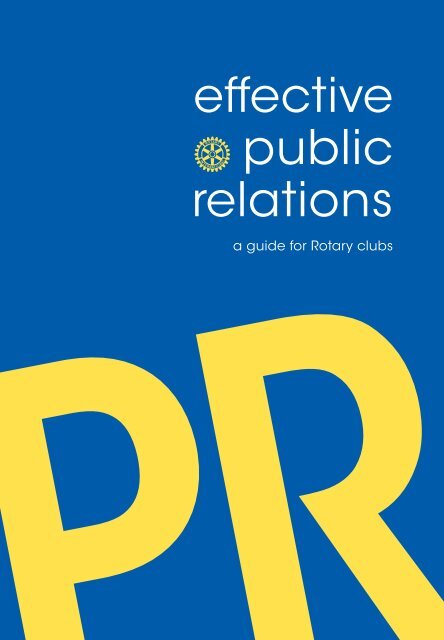
![La présidence du club [222-FR] - Rotary International](https://img.yumpu.com/25855726/1/190x245/la-presidence-du-club-222-fr-rotary-international.jpg?quality=85)

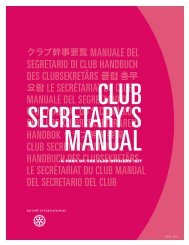


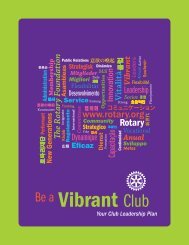
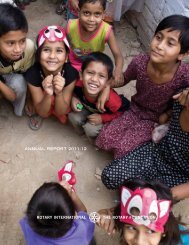

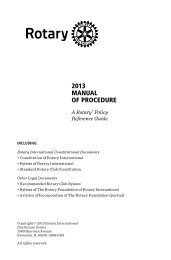

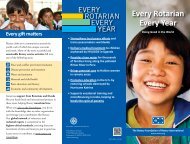
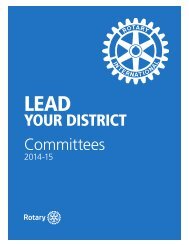

![La conférence de district [800-FR] - Rotary International](https://img.yumpu.com/25855636/1/190x245/la-conference-de-district-800-fr-rotary-international.jpg?quality=85)
